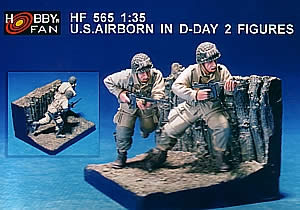| U.S.
Airborne in D-Day |
 |
|
It has been generally believed among historians, including 101st Airborne historian Mark Bando, that BARs were not used by paratroopers during D-Day. There was no practical way to break down and case this weapon for jumping into Normandy; it was too long and bulky. However, in early 2005 information emerged on Bando's Trigger Time website that there were at least one or two instances of paratroopers armed with BARs. So it still appears unlikely—but not impossible—that you'd see a paratrooper with a BAR in the early days of the invasion, unless he appropriated it from an unfortunate infantryman or gliderman who no longer needed its services. Both figures wear the M1942 jump uniform seen on D-Day. They have trench knives strapped to their legs, and the casting replicates the laces securing the bottoms of the knives to their ankles. The only extra gear provided are canteens and first aid pouches. The BAR gunner does have suspenders, so you could add a musette bag to his back if you'd like, but the lead soldier has none. In a nice touch, the Tommy gunner wears binoculars around his neck, but they are partially tucked into the front of his jacket. The sculpting is crisp, and the unidentified sculptor has done a great job with the folds of the uniform and capturing how the fabric strains against their bodies. The casting is virtually flawless, with just one thin speck of seam on the back of one of the figures. The weapons are equally well done, particularly the BAR, which is very delicate. You can see daylight between the barrel and the gas cylinder. But you'll need to be careful cutting off the casting plug from the underside of the helmets. The faces are also well done, but are a little too similar, with mouths open. If painting doesn't bring out differences, you could swap a head with another paratrooper from Sol or Warriors. The distinctive airborne helmet straps and chin cups are molded onto the heads. The base resembles a German trench, as might have been seen at Brecort Manor. It's also well executed, though there are no indentations in the earth where the feet are positioned, so if you use the base you'll want to make sure the soles of the boots are not hovering above ground. I like this set a lot. If you don't feel up to replacing the BAR, just pretend that your action scene takes place long enough after D-Day that the soldier may have picked up the BAR from some unlucky dogface from the 29th Infantry or the Big Red One. -tss- |
 |
 |
 |
 |
 |
 |
 |
 |
 |
 |
 |
 |
|
 Hobby
Fan
Hobby
Fan